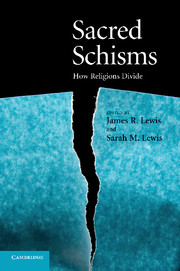Book contents
- Frontmatter
- Contents
- List of figures
- Notes on contributors
- Acknowledgments
- Introduction
- PART I THEORETICAL OVERVIEW
- PART II SURVEY OF SCHISMS IN SELECTED TRADITIONS
- PART III CHRISTIAN TRADITIONS
- 5 Finishing the Mystery: the Watch Tower and “the 1917 schism”
- 6 Challenges to charismatic authority in the Unificationist Movement
- 7 Persecution and schismogenesis: how a penitential crisis over mass apostasy facilitated the triumph of Catholic Christianity in the Roman Empire
- PART IV WESTERN ESOTERIC TRADITIONS
- PART V NON-WESTERN/POSTCOLONIAL TRADITIONS
- Index
- References
7 - Persecution and schismogenesis: how a penitential crisis over mass apostasy facilitated the triumph of Catholic Christianity in the Roman Empire
Published online by Cambridge University Press: 24 October 2009
- Frontmatter
- Contents
- List of figures
- Notes on contributors
- Acknowledgments
- Introduction
- PART I THEORETICAL OVERVIEW
- PART II SURVEY OF SCHISMS IN SELECTED TRADITIONS
- PART III CHRISTIAN TRADITIONS
- 5 Finishing the Mystery: the Watch Tower and “the 1917 schism”
- 6 Challenges to charismatic authority in the Unificationist Movement
- 7 Persecution and schismogenesis: how a penitential crisis over mass apostasy facilitated the triumph of Catholic Christianity in the Roman Empire
- PART IV WESTERN ESOTERIC TRADITIONS
- PART V NON-WESTERN/POSTCOLONIAL TRADITIONS
- Index
- References
Summary
Late in the year 249 CE, an extraordinary imperial directive was despatched throughout the extended domains of the Roman world. Monitored sacrifices to the gods were to be made by the empire's inhabitants, all of whom – excepting the Jews, whose ancestral monotheism enjoyed legal recognition – were to perform this act of devotional loyalty at their local temples. Commissions were empowered to oversee and record the mandated compliance, with census and tax rolls furnishing controls over identity. Specified times were announced for the stipulated observances, and signed certificates were issued to confirm the loyalty of all dutiful subjects. Here, from the preserving sands of Egypt, is one of forty-six surviving papyrus specimens, all of which were composed in a standardized petitionary form:
[1st Hand] To those superintending the sacrifices. From Aurelia Charis of the village of Theadelphia. I have always and continuously sacrificed and shown piety to the gods, and now in your presence and in accordance with the orders given, I have poured a libation, made sacrifice, and partaken of the sacred victims. I request you certify this for me. Prosperity to you. [2nd Hand] We, Aurelius Serenus and Aurelius Hermas, saw you sacrificing.
[1st Hand] The year one of the Emperor Caesar Gaius Messius Quintus Trajanus Decius Pius Felix Augustus, Payni 22 (= June 16, 250).
From its timing and manifest cultural logic, the purpose of this call for empire-wide sacrifice is not difficult to establish.
- Type
- Chapter
- Information
- Sacred SchismsHow Religions Divide, pp. 147 - 168Publisher: Cambridge University PressPrint publication year: 2009



